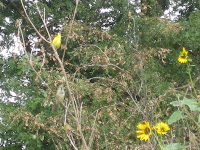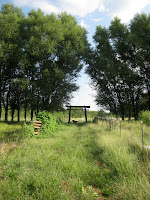I cannot count the times that I would walk out to the sheep and my heart would stop for a moment, when I saw Freckleface lying stretched on his side. Sheep don't DO that...unless they are dead or very nearly so. So I assumed the worst, every time. But invariably I would call to him, and he would lazily flick an ear in annoyance at my interruption of his nap. I would roll my eyes at myself for falling for his "trick" once again, and for "awfulizing" the whole scenario of what I would do with a dead animal weighing easily several times what I weigh.
Yesterday afternoon, it was different. A visitor and I walked out to see the sheep late in the day. I cannot say how I knew, but even from a great distance, even without calling, this time I knew he was dead. And indeed, he seemed to have given up the ghost only a short time earlier. Only a few flies had come, his eyes were just beginning to dull, rigor mortis had not set in.
He was in the vestige of shade cast by the trees on the east side of the pasture. He always got first dibs over the sheep for the best shade. He had rolled over on the electric fence, pressing it to the ground beneath him. He was not tangled in it in any way, and I doubt that very much current would pass through him with it pressed against the ground, with all that fur for insulation, and fairly dry conditions.
Aslan, the yearling ram that has been Freckleface's constant companion, was laying very close to him. When we approached, Aslan gave me a solemn, piercing look and rose and walked away. I felt he had been keeping a vigil with his dying/dead companion, and now was turning things over to me. He did not look back, and did not return to Freckleface's side at any time later while I was there.
The ewes and lambs seemed unconcerned. They had sought out scraps of shade as best they could, a tall tuft of grass near a fence post, or a grapevine "shrub", or a small elm tree, and were chewing their cuds.
The visitor and I dragged Freckleface off the fence with considerable difficulty. I really don't know how much he weighed; very roughly in the 300 - 500 lb. range. Much bigger than a large ram or deer. I mentally reorganized my life--at least the next 24 hours--as we walked in silence back to the house.
After my visitor left, I returned with my best sewing shears, and sheared Freckleface myself for the first and last time. This was a job reserved for our professional shearer, who is big and broad and experienced. It was always a private affair, rated "R" due to foul language and ugly behavior in both species. My greatest remorse is that this year I was not assertive enough in trying to get the shearer to schedule a date to shear him earlier in the summer, in June. An earlier shearing might have helped him weather the harsh heat and humidity better. Kansas is a tough climate for llamas. It ain't the Andes.
The next step was to dispose of the body. Options included: waiting until the next day and paying a renderer to come for it; getting someone with a backhoe to come dig a hole and drag him to it; or just going out there with a shovel. I immediately ruled out the possibility of composting (which has proven highly effective with sheep carcasses) because of his size: I would have had to purchase and haul in a lot of organic matter in order to have sufficient cover. The first two, obviously, would have entailed a lot less physical effort, but in some ways a lot more emotional effort, as well as some cash outlay. Besides, there is something very therapeutic about the physical act of digging. I think our culture's assignment of the digging of graves to non-relatives has aided our divorce from death as a natural process.
Two very dear friends were willing to come out after sunset and help me dig the grave. A BIG hole, about 3' x 7' and quite a bit deeper than I usually dig for sheep, to accommodate a thicker body. This is a job I would not suggest to very many folks. First, it had to be folks physically capable of strenuous work in still-harsh conditions, even after dark. And folks who were available late at night. Folks who had been around the farm enough to know Freckleface. Folks who didn't mind getting dirty. More than anything else, folks who wouldn't be overwrought at seeing a big dead animal, folks who would remain on an even keel emotionally, and offer me some ballast.
On my way back to the house from shearing him, I had opened the gates that I could without releasing the sheep, and moved the hoses that supply the sheep's water tank so that I would not run over any vulnerable fittings with the truck when we drove back out in the dark. The torii is, by design, just wide enough for the truck to fit through, give or take a folding mirror. Usually it is ambiguous, but last night the sacred space that the torii defined was clearly the pasture side, the burial ground.
We quietly assembled and gathered tools at the barn in a measured pace, placing them in the truck. Thinking through the task ahead, not wanting to hike back to the barn, letting the calm of the darkness enfold us. No tears, no hysterics, no big deal. A simple job to be done. Some walked, some drove to the field.
I had not thought much about where to put the grave. I mentioned to one of my companions that I was thinking about putting it near the Willow Row, where the long-dead sheep from the farm's first "worm storm" lie, along with Grace who died of a ruptured spleen, and the Lincoln ewe who went septic, and Lina who hung herself in a grafting stanchion, and the one who birthed her uterus while leaving the lambs in her belly. My friend thoughtfully reminded me of tree roots....
As I eased the truck through the torii and swung between the posts of the half-built fence to the southeast paddock, the headlights glanced on the post that marked the location of the first dodder infestation. The pasture was still a little skimpy there. It was someplace slightly less random than the rest of the pasture. Good enough.
The task took about 2 hours, start to finish. We proceeded at a steady pace, reminding ourselves several times that it wasn't a race. Over and over, we remarked on the blessing of stone-free, un-clayey soil. We took breaks to guzzle water, eat bananas (to replace electrolytes), look at the stars, rest, shift hands. Our workplace was lit by a small solar yard light and two battery headlamps--a dim puddle of light on the dark pasture, not harsh and glaring light the truck headlights would have been. There is a quiet, solemn camaraderie in digging together in the dark for this purpose, a bond that renders too many words superfluous.
From previous diggings, we knew to put a tarp down to place the dug soil on so that we wouldn't have to rake it out of the tall grass at the end. Instead, we could pull the tarp upside down over the grave mound to roll the last layer of soil off of the tarp.
From this burial, we learned (again) not to put the clods of sod down on the tarp, under the loose soil, where they interfered with scooping up the last bits of soil from the tarp. Remnants of straw on the tarp commandeered from another purpose also got in the way at the end.
We used the truck and some tow straps to drag the carcass to the grave, opening and closing electric fences as we went. We pulled him alongside the grave, then stood on the far side and used straps on his legs to pull him in.
There is a particular muffled thump that is the sound of a dead body settling to the bottom of a grave.
Some of the rigor mortis had passed, and his front legs folded up neatly under him. His head lolled back on his shoulder. But the hind legs were still stiff, and wouldn't bend, and his toe-tips were right at the surface. Not good. Eventually we got them to stay down along his belly, by digging little caverns for his feet in the side of the grave. To do this, I stepped into the grave myself, standing gingerly on the firm, shifting bulk of his shoulder, using my foot to press the stubborn limbs into position.
One has to stay in the moment, serenely matter-of-fact, attending simply to doing the next indicated thing, to keep such a task from becoming too macabre to survive. This is why it is so important to have the right companions. Even while I was still in the grave, my co-workers began gently pushing dirt back into the hole. There was no sense in not doing so; if we rested too long, weariness would overcome us. Again, why it is so important to have the right companions. Joking could too easily go awry.
We had begun the task with the goal being to get him in the grave with a few inches of dirt over him. If we wore out before all the dirt was returned to the hole, it would be fine to finish in the morning, or even to engage a neighbor with a tractor and blade or a skid loader to push the dirt into the hole. But we never really tired. We kept going until the job was done, a good sense of completion.
There is nothing that fixes the reality of a loss in one's mind like the physical task of digging the hole and settling in the body. A good sense of completion.
Thank you, friends.
Thank you, Freckleface.
 Toss was a very good dog,
Toss was a very good dog, Toss was a very good dog,
Toss was a very good dog,














